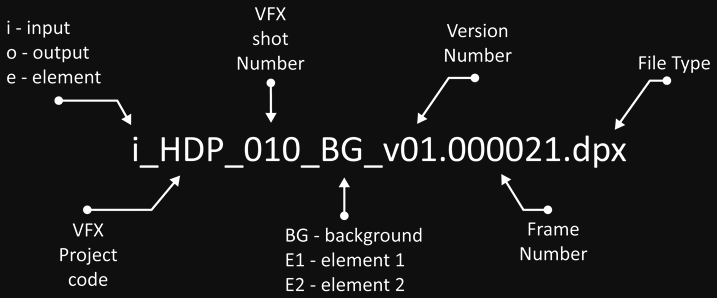I wish I’d made this. I’m currently writing a very dry document to basically say the same thing.
Tag Archives: management
Information is always lost as stuff is passed around different studios during post-production. A good naming convention can help prevent confusion.
- i means input (input to VFX system)
- HDP is the project name.
- 010 is the vfx shot number.
- BG the plate name.
- v01 is the version.
- 000021 the frame number
- dpx is the file type
So how is this used?
Continue reading
Like it or not spreadsheets are just too useful. Having the right formula to hand can really make things easier. Plus for me writing a bit of code serves to alleviate the tedium of data entry.
This expression will calculate the difference between two timecodes and spit out the answer in frames. Each cell must written using 11 characters in the standard timecode format. e.g. 10:23:07:24
This version works at 25 FPS and will subtract the IN point cell ‘G4’ from the OUT point cell ‘H4’.
((MID(H4;1;2)*3600+MID(H4;4;2)*60+MID(H4;7;2))*25+MID(H4;10;2))-((MID(G4;1;2)*3600+MID(G4;4;2)*60+MID(G4;7;2))*25+MID(G4;10;2))
You can change the frame-rate by swapping the 25 for a different number.
How it works
The MID function simply grabs individual characters from a cell.
MID(H4;7;2)
Will grab 2 characters from cell H4 starting with the 7th character in the string.
E.g. It will grab 07 from 10:23:07:24
MID(H4;7;2))*25
07 seconds * 25 fps = 175 frames
Being clear.
I believe that its important to maintain honest working relationship with my clients. I do my best to be clear about what I’m doing, why I’m doing it, and what I think is expected of me.
As we move through the project I make verbal agreements with my client. This can become the start of a schedule , production design, mood board… This is kind of a working contract which everyone buys into and constantly refreshes. Because we are tailoring it to to our needs most people on the project will read it.
Contracts
I understand that I formal contract is useful if things go wrong and you have to go to court. If this case I guess your going to arguing over the technical semantics of a document. So I see that ideally ‘written legalise’ is simple trying to be very specific. But it also makes it difficult to read.
This web site may be useful if you’re looking for standard contracts. http://www.own-it.org/. You’ll have to pay for the full contract but the excerpts are very informative.
Intellectual Property. Who owns the Art?
IP can be an issue. As freelance artist or contractors we have different needs and rights versus employees which clients may not understand or be aware of. Generally the client will own the final product of any work. The ownership of assets used to create that product can be a little fuzzy. It kind of depends where you are in the scale of employee to mini production studio.
In principle. If I’m modifying with someone else’s assets with their software they keep the the result. If I’m modifying my own assets with my software then I keep the result
When working as a contractor in my own office then I retain the rights to all assets apart from the final product that my client has actually paid for. Assets that I create or modify to generate that product are not own by my client. Without this kind of clause it would be impossible for me to maintain asset libraries of: textures, sounds, movies, MAXscripts and all the other stuff I need to do my work cost effectively.
If you were working with an ad agency you might see a clause like this.
Ownership
(a) As between you and us, all advertising materials prepared by us and accepted and paid for by you for use in advertising hereunder shall become your property. It is understood that there may be limitations on the use and ownership of materials by virtue of the rights of third parties. Whenever possible, we shall advise you of the
existence of such limitations.
(b) At termination of this agreement, you agree that any advertising, merchandising, packaging and similar plans and ideas prepared by us and submitted to you (whether submitted separately or in conjunction with or as part of other material) but not used by you, shall remain our property unless it was either mutually agreed in writing that any such plan or idea became your property, or specific payment of the cost of its development was agreed upon and made by you. You agree to return to us any copy, artwork, plates, or other physical embodiment of the creative work relating to any such ideas or plans, which may be in your possession upon termination.
Caught this article in the Guardian today. The jazz of entrepreneurship may be pushing it a bit. But as a musician I guess I feel there are many similarities in directing artists of all kinds be they musicians, actors, animators, compositors.
If I want to get the best out of someone then I need a day to day instinct for what they can achieve, and what they need to do it. Pushing too hard can be as counter productive as pushing to little.
If I’m improvising with a band then I need a moment to moment instinct for where people are and what’s going to happen next. Some of this instinct is based on knowing the music some of it is based on knowing the people.
There are a bunch of techniques I use in art management and direction. I guess a good creative meeting is a bit like a good jam…
You can read the academic paper here






